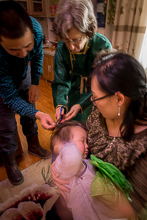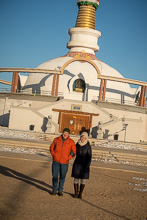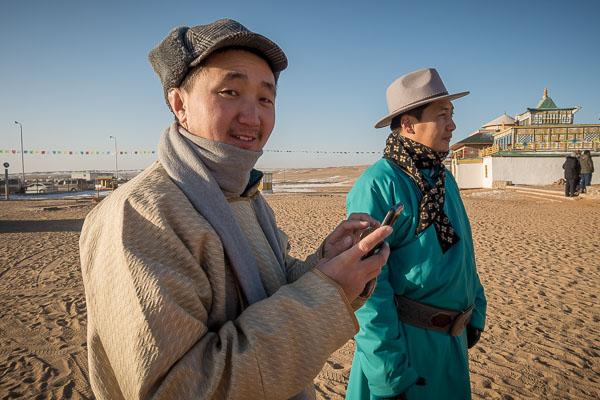A First Haircutting Expedition

Judy Takes Her Snip
Fortunately, my first cultural lapse (in this realm) happened with my own hat, which I took off to play basketball and tossed—tossed—on top of my coat, which I (thoughtlessly) piled in a corner of the gym floor. Eventually an incredulous colleague asked me why I had treated my coat, and especially my hat, with such disrespect. The usual place for a hat is somewhere high and safe—certainly not the floor, a place which I've been told many times now, disgraces the spirit of clothing, a knapsack full of groceries, or a computer bag. Because it is worn on your head, a hat requires extra care.
Since there is no parallel in our culture to the importance Mongolians place on a person's head, it is hard to begin to grasp the importance a child's first haircut. We had been invited to this first-hair-cutting-ceremony by Munkhbold, younger brother of Davaa, friend from Khovd who, though she speaks no English, has shared a very rich dose of Mongolian culture and hospitality with us. We have learned about her extended family's camel herd, visited her ger, eaten her (or her daughters') cooking, shared a sheep that was killed for us, and sampled home-made arikh, vodka distilled from fermented milk, and khoomis, fermented camel's milk—try to imagine beer and buttermilk. So when her little brother, a neurology resident, showed up at my (fourth floor) door one day with his sleeping daughter draped across his arms, struggling to explain who he was and asking if I could help him with his English, there was only one gracious answer. Of course, (Judy was working in Darkhan at the time) I will try to help.
Though I taught English for a year in Khovd, I had no experience with beginning English learners, and no books or guides to help me. Most of my dealings with Mongolians have been possible because, even at a low level, their English is better than my Mongolian. With Munkbold though, we are both on equally unsteady footing. Our strategy has been to just meet and talk, use the language the best we can. I have been forced to use whatever little Mongolian I can muster as we arrange meetings, attend wrestling matches, or now, make plans for taking a ten hour train ride to visit his family in Sainshand, where he has lived since finishing medical school in Ulaanbaatar.
A week and a half before the ceremony Munkhbold came to our apartment to make the plan. Judy and I would take the train on Wednesday. We would find a driver, sleep in a hotel. There would be a museum to see, maybe two. We would travel to the Energy Center, sometimes, in Mongolia, The Energy Center of the World, then go to his home for the cutting ceremony. We would be brought back to Sainshand in time to catch an overnight train back to Ulaanbaatar for a commitment the next day. We should bring gifts. Several versions of a map and a timetable were drawn. I thought I understood, but, experience reminding me now, maybe not. After two days of trying to get another friend to help me buy tickets, another call from Munkhbold. We would go to the train station, buy the tickets—now. At this point, at least he knows the same thing I know about our arrival and departure. As he is catching a bus, Munkhbold says he will need money for the hotel, for the driver. I give him a hundred thousand tugrigs and say goodbye. That is the plan. We would see him in a week.
There was uncertainty about what would happen next, starting with the gifts. At a cultural education program provided by the US Embassy for Tsagaan Sar, I asked what an appropriate gift for a hair-cutting ceremony might be. "A hat," I was told by the Mongolian instructors. "It is still very cold out, especially with no hair." (Don't I know, but we are just foreigners. Surely someone else will know what the proper hat would be. We decided on toys and money, something that made everyone happy.) Shortly after leaving the station in Ulaanbaatar, I sent a text to Munkhbold, telling him that we were on the train and headed his way. There was no response, so as we stepped off the train to the dark platform after our ten-hour ride it was reassuring to see that Munkhbold was there to greet us. His friend with a car was waiting in the parking lot. After taking us to his apartment for dinner, we walked to the hotel, where a room was ready for us.

At the Energy Center
Returning to Sainshand, we were dropped off at our hotel, with instructions to come to Munkhbold's apartment late in the afternoon. Although we didn't know it at the time, there would be one shift after another passing through Munkbold's house, each person taking a snip, dropping an offering into a plastic bag that each child held in their lap, eating food that ranged from buuz, tomato and sausage or potato salad, to a salad that is made from thinly sliced slivers of a sheep's stomach.
By the time our appointment came, we had explored the city, visited the museum, and seen the small pink replica of the Eiffel Tower that sits in the center of the city. Munkbold and his wife and his mother had dealt with their obligations to the rest of their friends and family. From each child, a boy and a girl, Judy and I took a small snip of hair with scissors wrapped in a khadig, blue silk ceremonial cloth. We dropped our money offerings into the bag, presented the toys to ease the stress of being on display all afternoon. Then, as we ate, the unscripted part of the ceremony unfolded as parents dealt with the results of an afternoon of random hair hacking. As well-worn electric clippers vibrated to a loud clatter, children hid behind curtains, screamed, did what was possible to defend themselves. A short moratorium, regrouping to repair the clippers and persuade children to give it another chance, and the job was finished. For each child, the results of the shearing were carefully wrapped in cloth, then tied and stored in a bag where they will be kept by the parents, from all reports, forever.

